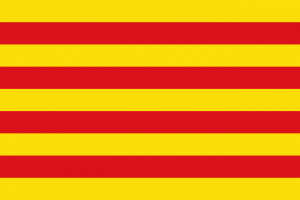Language/Catalan/Grammar/Nouns
Hi Catalan learners! 😊
In this lesson, we will learn about the basic rules of Catalan nouns. Nouns are a fundamental part of any language, and proper use of nouns is necessary for clear and effective communication. As a Catalan language teacher with 20 years of experience, I will guide you through the ins and outs of Catalan nouns. We will explore the different types of nouns, their gender, number, and usage.
Don't hesitate to look into these other pages after completing this lesson: How to say "there is" in Catalan, Indefinite Articles in Catalan, Introduction to prepositions & Gender.
Noun Types[edit | edit source]
Nouns can be classified into different types based on various criteria, such as their meaning or their form. Let's explore the most common types of Catalan nouns.
Common Nouns[edit | edit source]
Common nouns refer to general categories of people, objects or concepts. They are not specific to any particular person or thing. Examples include "gat" (cat), "casa" (house), and "llibre" (book). Common nouns are usually not capitalized, unless they appear at the beginning of a sentence.
Proper Nouns[edit | edit source]
Proper nouns are specific names of people, places, or things. They always begin with a capital letter. Examples include "Barcelona" and "Jordi".
Collective Nouns[edit | edit source]
Collective nouns refer to groups of people, animals or things. Example of collective nouns in Catalan include "família" (family) and "equip" (team). Collective nouns can be singular or plural, depending on the implied number of individuals in the group. In general, they are treated as singular nouns when referring to the group as a whole, and as plural when referring to individual members of the group.
Abstract Nouns[edit | edit source]
Abstract nouns refer to ideas, qualities or concepts that cannot be perceived by the senses. Examples include "amor" (love) and "llibertat" (freedom). Abstract nouns are always singular and are typically not preceded by an article.
Gender[edit | edit source]
Catalan, like many other Romance languages, assigns a gender to each noun. There are two genders: masculine and feminine. The gender is indicated by the article that precedes the noun.
Masculine Nouns[edit | edit source]
Masculine nouns are usually preceded by the article "el". Examples include "avio" (airplane) and "llibre" (book).
Feminine Nouns[edit | edit source]
Feminine nouns are usually preceded by the article "la". Examples include "casa" (house) and "lluna" (moon).
Exceptions[edit | edit source]
There are exceptions to the gender rules. Some nouns have a fixed gender, regardless of their meaning. For example, "mare" (mother) is always feminine, while "pare" (father) is always masculine. Other words have different meanings depending on their gender, such as "puma" (male puma) and "puma" (type of shoe worn by women).
Number[edit | edit source]
Like gender, nouns in Catalan are either singular or plural. The plural of a noun is usually formed by adding the suffix "-s" to the singular form. However, there are many exceptions.
Singular Nouns[edit | edit source]
Singular nouns refer to one person, object, or concept. Examples include "gat" (cat) and "poble" (village).
Plural Nouns[edit | edit source]
Plural nouns refer to two or more people, objects or concepts. Examples include "gats" (cats) and "pobles" (villages).
Special Cases[edit | edit source]
Some nouns have irregular plural forms, such as "home" (man) and "dona" (woman), which become "homes" and "dones", respectively.
Usage[edit | edit source]
The usage of nouns in Catalan is similar to that in English. Nouns can be used as the subject or object of a sentence, or as the object of a preposition.
Subject Nouns[edit | edit source]
Subject nouns are the main "actors" in a sentence. They perform the action expressed by the verb. Examples: "El gat dorm" (The cat sleeps) and "La casa és gran" (The house is big).
Object Nouns[edit | edit source]
Object nouns receive the action expressed by the verb. They can be either direct objects or indirect objects. Examples: "Vaig comprar un llibre" (I bought a book) and "Le vaig donar el llibre" (I gave him/her the book).
Object of a Preposition[edit | edit source]
Nouns can also be used as the object of a preposition. Examples include "a prop de la casa" (near the house) and "amb els llibres" (with the books).
Dialogue[edit | edit source]
- Person 1: Hola, com et dius? (Hi, what's your name?)
- Person 2: Em dic Pere. I tu? (My name is Pere. And you?)
- Person 1: Sóc la Maria. On vius? (I'm Maria. Where do you live?)
- Person 2: Visc a Barcelona, i tu? (I live in Barcelona, and you?)
- Person 1: Jo també. Què fas? (Me too. What do you do?)
- Person 2: Sóc estudiant. I tu? (I'm a student. And you?)
- Person 1: Treballo com a mestra. (I work as a teacher.)
Conclusion[edit | edit source]
In conclusion, knowledge of Catalan nouns is crucial for effective communication in the language. In this lesson, we have learned about the different types of nouns, their gender, number, and usage. To improve your Catalan Grammar, you can also use the Polyglot Club website. Find native speakers and ask them any questions. Don't forget to also check out our other Catalan grammar lessons on the website, under the Grammar category.
Sources[edit | edit source]
Impressive work on finishing this lesson! Explore these additional pages to enhance your understanding: Ordinal Numbers in Catalan, Introduction to adjectives and adverbs in Catalan Grammar, Pronouns & Present Continuous in Catalan.

